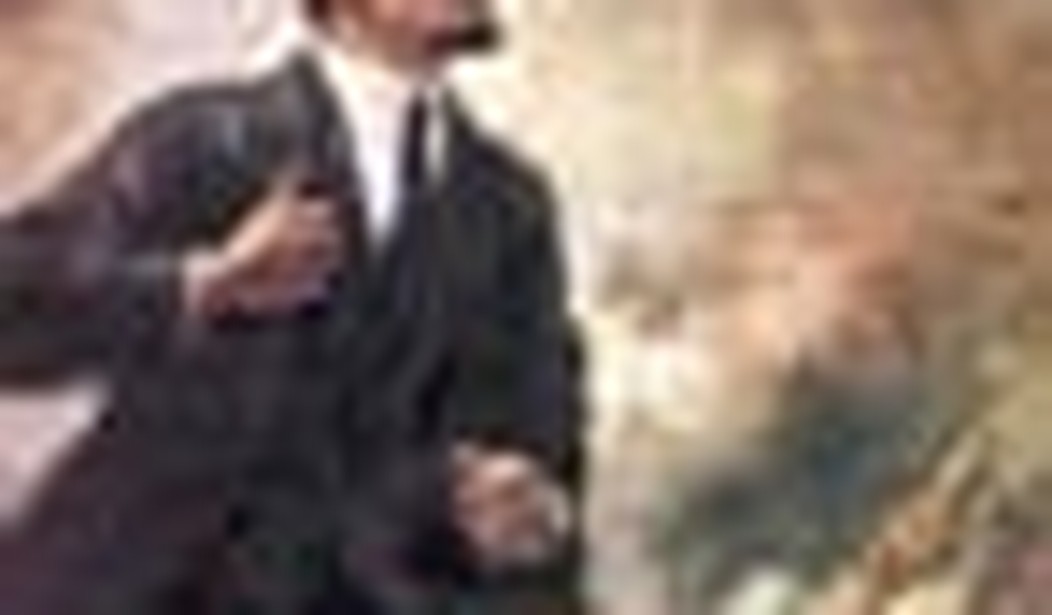My earlier article “Obama the Pitchfork Operator: A Remake of the Soviet Classic” pointed out the similarities between Obama’s and Stalin’s methods of governing by pitting unions against businesses. Many readers have emailed me asking to write more and compare the roles of the unions under socialism (as it existed in the USSR) and capitalism (as it exists in the USA). This essay is an expanded response to their questions.
The “card-check” debates in the U.S. Congress reminded me of my own experiences with trade unions in the USSR, where organized labor was part of the official establishment and union membership was universal and mandatory. It also reminded me of how that system’s seemingly magnanimous goals — fairness, economic equality, and social justice — in real life brought forth a rigged game of wholesale corruption, forced inequality, and grotesque injustice.
Years later, the same Orwellian misnomers are catching up with me in America. One of them is called the “Employee Free Choice Act” — a piece of legislation that deprives workers of free choice by replacing private balloting with publicly signed cards in the presence of pushy union organizers. Bad as it is, card check is only a means to a larger end. Proponents of “redistributive justice” would love nothing more than to use a forced expansion of labor unions as a vehicle to deliver America straight into a utopian swamp, where they will gain extraordinary powers while the rest of the nation will be doomed to repeat the Soviet scenario of slow death from social, economic, and moral decay.
Defeating the card-check bill alone will not affect the ideology that has spawned it, just as curing a symptom of a disease will not remove the infection. It is the ideology that we must address and learn to recognize in its various manifestations.
No matter where I worked in the USSR, I was always a union member without so much as a formal notice — starting with the student union in college and then on to whatever union was assigned to the state-run enterprise that hired me, regardless of the job description. The only indicators of this one-sided relationship were monthly union dues, automatically deducted from my measly wages. It was like paying alimony for a fling I never had. To be fair, in the early 80s, I did go on a union-subsidized one-week tour of Uzbekistan — mostly because a friend knew someone at the union office who owed him a favor. But that was it.
Every time I visited a union office in the USSR, I saw the same prominently displayed poster: “Trade unions are a school of communism — V.I. Lenin.”
At the time it seemed like a sweeping exaggeration, similar to other Lenin gems like “communism is Soviet power plus the electrification of the entire country,” which any student of arithmetic could reformulate as “Soviet power is communism minus the electrification.” But recent events in American politics have made me wonder whether the union movement might actually be all that Lenin’s quote implies and more — a school, a workshop, and a gateway to communism.
Ideologically, both unionists and communists share the slogan of “economic equality and justice” — two incompatible concepts, given that just rewards make people economically unequal, while forced economic equality leads to great injustice. The pursuit of these contradictory goals in real life results in a dreary outcome. Since absolute equality is unattainable for reasons we will discuss later, forcing it on a society only replaces natural inequality with forced inequality. In this sense, the difference between the two movements is in their radius: communists fancy a forced “economic equality and justice” for all, while the unions limit it to the select group composed of their members.
Strategically, both movements work toward their goals by divorcing wages from labor productivity, stifling the free market, and expropriating and redistributing wealth — all the while blaming the resulting failures and misery on the capitalist “enemy.” This can put even non-communist union members in a state of mind that makes them ripe for Marxist propaganda. We can see why Lenin considered communism to be the final destination of the union movement.
In theory, unions become workshops of communism only when they go beyond their original legitimate purpose of collective bargaining and taking care of work-related issues (safety, training, etc.), and turn into collectivist pressure groups that engage in class warfare. In practice, however, there hardly is a union in existence that hasn’t become a tool in wealth redistribution schemes that use the “common good” as an excuse for voter fraud, coercion, intimidation, and diverting membership fees to support anti-business policies.
The ultimate result of the unions engaging in class warfare was exemplified by the misery of unionized workers in the USSR, whose fleeting desire to be “free from the shackles of capitalist exploitation” led them into permanent slavery at the hands of the state-run economy. As soon as the factories were turned over to the workers, union perks were reduced to little red flags with Lenin portraits, badges, and honorary titles like “the collective of communist labor.” In American terms, that roughly translates into awarding a “best carmaker of the month” bumper sticker to an auto worker who can’t afford a car.
Union perks mean nothing when there is nothing left to redistribute. The Soviets learned it the hard way. The American unions don’t seem to be able to learn from the mistakes of others and admit that their own perks can only exist in a free and competitive economy that ensures growth and generates wealth — also known as “capitalist exploitation” in the lingo of the champions of “redistributive justice.” By promoting a state-regulated economy and undermining private businesses whose employees they claim to represent, the unions objectively undercut the workers, who are paying for it with lost jobs and incomes. Setting up the capitalist economy for destruction in this manner qualifies the unions as “a school of communism.”
This is not an anti-union argument. To call it anti-union, one has to believe that a union’s main purpose is to siphon the nation’s wealth to its members. Or that the unions were created to provide logistical support to leftist radicals in their struggle for power. My argument is quite the opposite: since such overreaching by the unions is self-destructive and ultimately hurts the workers, ridding the unions of inappropriate functions and alliances would benefit everyone — the society, the workers, and even the unions themselves.
The workers are not herd animals; nor are they a separate biological species with a different set of interests. They are as human as anyone else who possesses a mind and free will, and therefore their long-term interests are not different than the rest of humanity. And since the interests of humanity lie with liberty, property rights, and the rule of law, this is what the unions should stand for.
The shining example of this is Poland’s Solidarność, an independent union that spearheaded the overthrow of the oppressive communist regime in 1989. Or the struggling labor unions of Iran, who oppose the corrupt and oppressive theocracy of the mullahs and could use a little more international solidarity right now, as their leaders suffer beatings, imprisonment, and persecution at the hands of the Islamic Republic’s Revolutionary Guards.
Too often, however, the unions blindly take the opposite side and support state-enforced redistribution of wealth, forgetting that whenever a government adopts forced economic equality as official policy, unions become redundant and lose not only their political power but also their very raison d’être. That is exactly what happened to the unions in the USSR.
When Lenin’s party was plotting to take over Russia, it encouraged the unions to engage in class warfare on the party’s behalf and spread the ideas of economic equality and redistribution of wealth. But as soon as the party was in power, all such activities were discarded. In the words of prominent party theoretician Nikolai Bukharin, “We asked for freedom of the press, thought, and civil liberties in the past because we were in the opposition and needed these liberties to conquer. Now that we have conquered, there is no longer any need for such civil liberties.”
Following the October Revolution in 1917, Russia’s former Allies in World War I — France, Britain, and the U.S. — launched a limited military intervention into Russia, seeking to restore the democratic Provisional Government and defeat the communists who annulled Russia’s foreign debt and confiscated private property held by foreign nationals. But the Allies were defeated — not by the Red Army, but by their own labor unions, who launched a campaign of solidarity with “the first workers’ state,” threatening to paralyze their war-stretched economies. By 1920 the Allies withdrew without much of a fight and the communists won.
But inside the “workers’ state” itself, labor unions were reduced to the position of puppets. Any greater role would have put them in competition with the party that claimed to speak for the “toiling masses.” It stands to reason that a state that runs a command economy would subdue the unions and make them a tool of control over the workers. That was why parading the aforementioned quote from Lenin in union offices didn’t make sense to me.
The squashing of union power was gradual. For a few years after the revolution, unions enjoyed some nominal independence. The 1922 labor code closely resembled those in Western countries, while labor productivity remained only a fraction of Western productivity. Sooner or later this contradiction had to be corrected.
The initial understanding was that, by toiling conscientiously for the common good, the workers would become more productive. That never happened. When all the motivational sloganeering, appeals to the workers’ conscience, and government mandates to improve productivity failed, the Soviet leaders knew they had hit a wall. The only variable in this equation subject to the party control were workers’ rights — and they were slashed one by one without so much as a squeak from the unionists who had brought it on themselves.
By the 1930s, the unions were officially absorbed by the state, having become a subdivision of the Labor Commissariat, but without the commissariat’s authority. Most of the labor code had already been rendered obsolete. A single day’s absence was punishable by dismissal and, later, by imprisonment. The state practiced compulsory assignment of graduates to workplaces. Being late for work or leaving early became an offense against the state.
Things kept getting worse, as repression proved to be the only possible way to propel the inefficient state-run economy, with fear and intimidation its only incentives. By 1940, a worker could no longer resign from a job without the consent of the management, while the state reserved the right to transfer employees at will and without their consent. Local wage increases depended on decisions made in Moscow. The old labor code was removed from usage and no longer published.
A sad joke from that era describes the repressive political climate as follows. Three gulag prisoners are sharing stories of how they got there: “I came to work five minutes late and was accused of sabotage.” “I came to work five minutes early and was accused of spying.” “I came to work on time and was accused of being a Swiss secret agent.” (It was only logical that economic inefficiency would lead to official xenophobia — a paranoid cousin of unionist protectionism.)
Upon Stalin’s death in 1953 the terror still lingered for several years. But the reforms of the 1960s already brought a new labor code that gave workers more rights than they could remember. And since the unions were now part of the totalitarian state, union membership was automatic and compulsory, with dues automatically deducted from the salary.
Despite the new labor code, the unions never regained independence. Their functions were limited to family care, recreation, and boosting workers’ morale. Union functionaries busied themselves sorting out family quarrels, or putting the fear of the party into philandering husbands and alcoholics who were absent from work for several days but couldn’t be fired because unemployment wasn’t supposed to exist.
Unemployment benefits didn’t exist either. If you didn’t have a job the state would find one for you, whether you liked it or not — including sweeping the streets. Since the government owned all industries and services, it could create any number of additional jobs, regardless of economic necessity. Resisting employment by the state was a criminal offense. A brief period without a job was tolerated, but deliberate prolonged unemployment could get one arrested, labeled a “social parasite,” and sent off to a labor camp for reeducation. The usual suspects were dissidents, vagrants, and dysfunctional alcoholics.
While union representatives were prone to unleash “collective indignation” on “unconscientious” workers, few took their moralizing seriously. In the absence of Stalinist terror as an absolute motivator, the “toiling masses” viewed their relationship with the state as a big joke: “they pretend they’re paying us, we pretend we’re working.” The economy was faltering, causing an even greater scarcity of goods, irregular food supplies, and rising prices.
The only known independent workers’ strike in Soviet history happened in 1962 in the Russian city of Novocherkassk. Not surprisingly, the unions played no part. It was an unplanned, impulsive outburst caused by the announcement that the government had increased prices on basic food products. Workers at the Electric Locomotive Construction Works were the first to walk out on the job. Most of them were promptly arrested and locked up at the local police station. The next morning, thousands of men, women, and children marched in a column towards the government building to express their demands and to free the arrested workers.
Khrushchev’s relatively liberal reforms hadn’t made speaking against the government any less dangerous, but the workers had become too desperate to care. The procession towards the downtown area was mostly peaceful, but random participants reportedly assaulted the party and KGB representatives who had been trying to stop them, threatening people with retribution. At the same time the demonstrators freely fraternized with the locally stationed soldiers, posted to deny them passage across the bridge.
The frightened officials dispatched ethnically non-Russian special forces who were less likely to mix with the locals, and reinforced them with ten tanks and several armored personnel carriers. In the clash that followed, the soldiers shot at the demonstrators from automatic rifles, killing about 70 people and leaving hundreds wounded. How many were imprisoned remains unknown because the incident was hushed from the outset, and the convictions were likely to be veiled as theft, hooliganism, or banditry.
There were no strikes after that for a very long time, non-union or otherwise. Due to the government’s total control of the media, no information about the strike and its suppression spilled over the city limits, let alone into the Western press. The media first reported it during the period of Glasnost in 1989 — twenty-seven years later.
Around the same time, as the hold of the party was already waning, Soviet coal miners went on a nationwide strike, the first since the revolution, against the corrupt communist rule — a strike that was not suppressed by the government and was widely reported in the Soviet and world media. Again, unions played no part in it. But they picked up the initiative as soon as they realized the potential power they could wield as strike organizers. As if recovering from a decades-old amnesia, Soviet labor leaders gradually regained the skill of exploiting the workers’ anger for political purposes.
Already after the party had been disbanded in 1991 and the USSR was no more, unions continued with a series of strikes, this time directed against economic policies of new, barely hatched independent democracies. Under the guise of caring about the workers, the hard-line communist leadership of the unions did everything in their power to add to the existing havoc, destabilize the new governments, and make the workers plead for the return of the old system.
Read all about it in the next chapter.
Coming soon: “How Unions Bring Forced Inequality and Economic Injustice.”









Join the conversation as a VIP Member